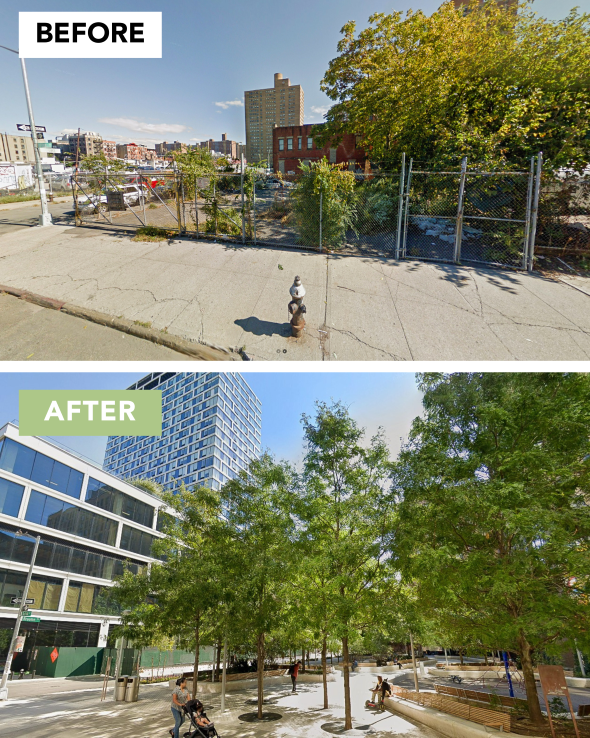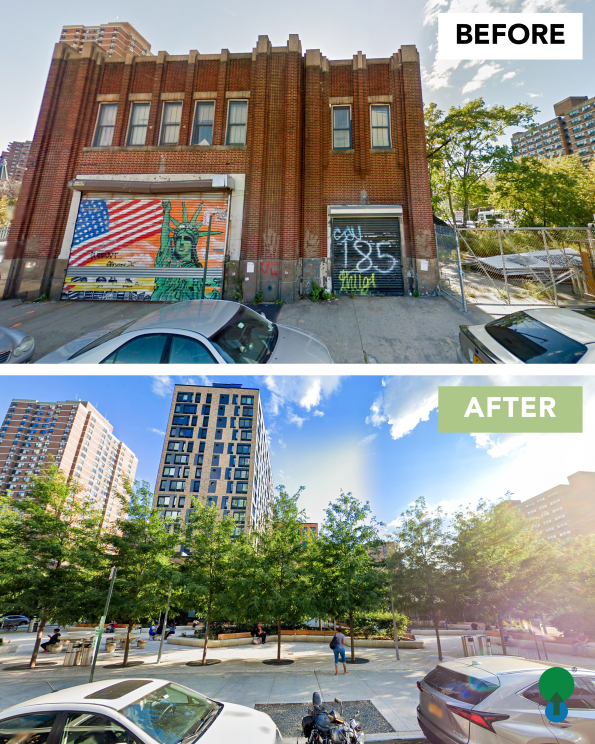The Vision Realized: A Green Haven in the Heart of NYC
Picture a typical abandoned corner in Manhattan: concrete, hardscape, untapped potential.
Now imagine that same space transformed into a modern park with a grove of honey locust trees. This is Seward Park today, where nature and urban design combine to create a relaxing escape within the bustle of New York City.
The transformation is nothing short of remarkable. It’s a blue-sky October morning in the Big Apple, and the bustling city is coming alive. On this corner, though, there’s a quiet, unaffected getaway. Honey locust trees in their full autumn glory cast dappled shadows on contemporary benches that curve organically through the park. A child plays on the modern jungle gym, her mother grabbing a chat with friends at a nearby table, screened in from the buzz of the city. Under the natural canopy, a student works on their thesis, finally able to focus in this peaceful, natural escape.
It’s a striking contrast to the shabby, neglected corner of before. In just seven years since installation, the trees have achieved exceptional growth rates, creating a verdant canopy that provides essential shade and natural beauty to this urban setting.


It’s a vision that many landscape architects would like to see come to life in the real world. For many, however, it’s difficult to achieve that in reality. So, what’s the science behind the success?
The System Below Successful Trees
The remarkable growth and health of the trees at Seward Park didn’t happen by chance. Behind this success story lies the GreenBlue Urban ArborSystem, a comprehensive planting system that creates optimal growing conditions below ground.
The system included:
This underground framework creates an environment where trees can thrive, not just survive. The proof is in the canopy – robust, healthy trees with consistent growth rates across all planted specimens.
Project
Location
Contractor
Landscape Architect
The Vision Realized: A Green Haven in the Heart of NYC
Picture a typical abandoned corner in Manhattan: concrete, hardscape, untapped potential.
Now imagine that same space transformed into a modern park with a grove of honey locust trees. This is Seward Park today, where nature and urban design combine to create a relaxing escape within the bustle of New York City.
The transformation is nothing short of remarkable. It’s a blue-sky October morning in the Big Apple, and the bustling city is coming alive. On this corner, though, there’s a quiet, unaffected getaway. Honey locust trees in their full autumn glory cast dappled shadows on contemporary benches that curve organically through the park. A child plays on the modern jungle gym, her mother grabbing a chat with friends at a nearby table, screened in from the buzz of the city. Under the natural canopy, a student works on their thesis, finally able to focus in this peaceful, natural escape.
It’s a striking contrast to the shabby, neglected corner of before. In just seven years since installation, the trees have achieved exceptional growth rates, creating a verdant canopy that provides essential shade and natural beauty to this urban setting.


It’s a vision that many landscape architects would like to see come to life in the real world. For many, however, it’s difficult to achieve that in reality. So, what’s the science behind the success?
The System Below Successful Trees
The remarkable growth and health of the trees at Seward Park didn’t happen by chance. Behind this success story lies the GreenBlue Urban ArborSystem, a comprehensive planting system that creates optimal growing conditions below ground.
The system included:
This underground framework creates an environment where trees can thrive, not just survive. The proof is in the canopy – robust, healthy trees with consistent growth rates across all planted specimens.
Project
Location
Contractor
Landscape Architect
Project
Location
Contractor
Landscape Architect
Principles to Apply to Your Project
The success of Seward Park offers valuable lessons for landscape architects and urban planners. Here are some key considerations for your next project:
The transformation of Seward Park shows that with proper planning, appropriate infrastructure, and attention to detail, urban spaces can become thriving green havens that serve both people and nature.
Principles to Apply to Your Project
The success of Seward Park offers valuable lessons for landscape architects and urban planners. Here are some key considerations for your next project:
The transformation of Seward Park shows that with proper planning, appropriate infrastructure, and attention to detail, urban spaces can become thriving green havens that serve both people and nature.

Please wait while you are redirected to the right page...